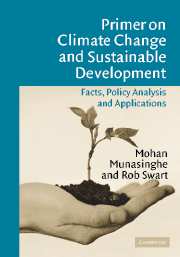Book contents
- Frontmatter
- Contents
- Foreword
- Preface
- 1 Climate change: scientific background and introduction
- 2 Future scenarios of development and climate change
- 3 Framework for making development more sustainable (MDMS): concepts and analytical tools
- 4 Interactions between climate and development
- 5 Adaptation to climate change: concepts, and linkages with sustainable development
- 6 Vulnerability, impacts, and adaptation by sectors and systems
- 7 Vulnerability, impacts, and adapation by geographic region
- 8 Mitigating climate change: concepts and linkages with sustainable development
- 9 Mitigation measures: technologies, practices, barriers, and policy instruments
- 10 Assessment of mitigation costs and benefits
- 11 Climate change and sustainable development: a synthesis
- Index
- References
2 - Future scenarios of development and climate change
Published online by Cambridge University Press: 25 December 2009
- Frontmatter
- Contents
- Foreword
- Preface
- 1 Climate change: scientific background and introduction
- 2 Future scenarios of development and climate change
- 3 Framework for making development more sustainable (MDMS): concepts and analytical tools
- 4 Interactions between climate and development
- 5 Adaptation to climate change: concepts, and linkages with sustainable development
- 6 Vulnerability, impacts, and adaptation by sectors and systems
- 7 Vulnerability, impacts, and adapation by geographic region
- 8 Mitigating climate change: concepts and linkages with sustainable development
- 9 Mitigation measures: technologies, practices, barriers, and policy instruments
- 10 Assessment of mitigation costs and benefits
- 11 Climate change and sustainable development: a synthesis
- Index
- References
Summary
Introduction and methodology
Climate change is a problem, which plays out over long timescales. Inertia in natural and socioeconomic systems plays an important role. If the emissions of greenhouse gases were to cease today, global temperatures would continue to increase for decades, and sea-level continue to rise for centuries. While household appliances could be replaced within years, replacement of major industrial installations and power plants and institutional structures can take decades, and changes in large-scale infrastructure, or fundamental human values, a century or more. While the evidence is mounting that climate is changing already, and impacts on natural systems have been identified, the main risks are expected to occur in the future. Exploring the options to address climate change makes the use of scenario analysis indispensable, since the future is unknowable and dependent on choices still to be made. Scenarios are images of the future and of the pathways towards such futures. They are not to be confused with predictions. Some scenarios are explorative – exploring how the future may evolve starting from the conditions of today and trends. Other scenarios are normative – describing a future to which the authors attach some value: it may be a desirable future, like a sustainable one, or it may be an undesirable one, in which the world falls into despair and chaos. It is impossible to predict the future and, hence, there is no such thing as ‘business-as-usual’.
- Type
- Chapter
- Information
- Primer on Climate Change and Sustainable DevelopmentFacts, Policy Analysis, and Applications, pp. 56 - 98Publisher: Cambridge University PressPrint publication year: 2005



